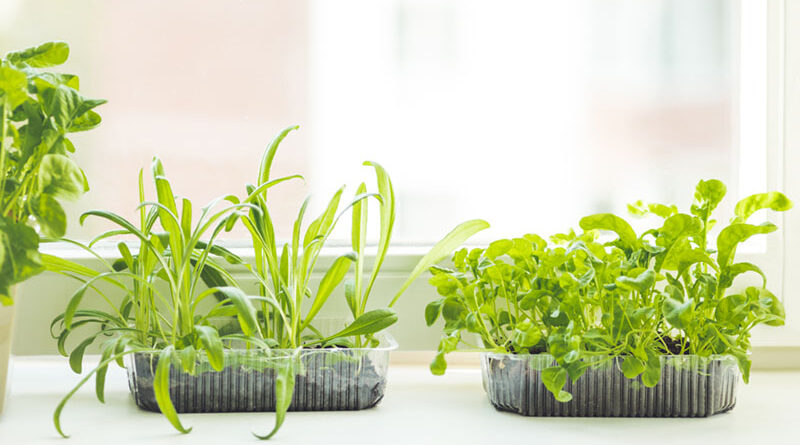Starting Seedlings
Getting an early start on gardening
By Deborah Jeanne Sergeant
Though the snow may still fly for a while, it is not too early to grow seedlings to plant this spring. But timing is everything.
“The number one problem most people run into while starting plants indoors in the wintertime is too early of a start date,” said Jay Nicholson, general manager of Frear’s Garden Center in Rochester. “They believe the earlier the start the more mature and the better season they’ll have with their plants. However, more often than not, the plants are stressed from being inside under limited sun and non-ideal conditions to where they do not prosper.”
Nicholson suggests working backwards on the calendar from the date of last chance of frost based upon the Farmers’ Almanac or consulting with the local Cornell Cooperative Extension for advice. Refer to the seed packet for how long it takes for seeds to germinate.
It may be tempting to plant indoors too early because greenhouses have been operating for a couple of months; however, Nicholson said that is because they can adapt their environment to suit their seedlings’ needs.
How long it takes plants to mature before they may be planted outdoors makes a difference.
“You need to know how long it takes for the seed to germinate and then grow on for a short period of time so it’s sturdy enough to be put outside,” said Marci Muller, horticulture program leader for Cornell Cooperative Extension of Monroe County.
For example, peppers are slow to start, but tomatoes and cucumbers grow quickly and if they spend too long in starter trays, they tend to get spindly.
“Some seeds start so quickly that there is no reason to start inside, like squash and beans,” Muller said. “We typically start inside plants that take longer. When we take them outside, we want an established plant already.”
Some fast-growing and cold tolerant plants are not worth growing inside, like lettuce, squash, beans, cabbage and peas. They grow so quickly that it’s easier to plant their seeds outdoors.
“You should probably start peppers in March,” Muller said. “The others, you could put off until the end of March.”
Muller recommends planting one to two seeds in each cell of a small fiber pack containing seed starter mix. She said that the lightweight mix has good porosity and avoids drowning the developing roots.
“Cover it with plastic to hold the moisture in,” she said. “That can keep it warmer. If you aren’t somewhere where it will be 60 or 65 degrees, you can put it on a heat mat so you’re warming the soil. You water it and cover it with plastic and you shouldn’t need to water it again until everything starts to pop up. You don’t want to over water it.”
Once the seedlings pop up, remove the plastic off and keep them in a sunny window. If they start to outgrow the cell, the seedlings may be transplanted into a larger container.
“If they start to get leggy, pinch where the top leaves are,” Muller said. “When things warm up, put the seedlings outside during the day but bring in if it gets below 40. That will toughen the plants up. When we get closer to mid-May and they’re ready to plant, they’ll be nice and sturdy.”
Peat pots or fiber pots should be broken up before planting to ensure the roots can get to the soil. If the pots dry out and do not break down, the roots cannot go through properly.
Nicky Martell, flower mall manager at The Garden Factory in Rochester, recommends keeping indoor seedlings near a heat vent and in direct sunlight.
“If you don’t have a sunny, bright location, grow lights are an effective tool,” she said. “You could use a regular lamp with a grow light bulb. The UV in them is different.”
Joe Edmond, greenhouse manager at Green Acre Farm & Nursery in Rochester, advises keeping an eye on the weather before taking seedlings out to plant.
“Every year is different,” he said. “You have to get past the threat of frost. Broccoli, cabbage, cauliflower, Brussels sprouts, lettuces and chards will tolerate cold temperatures. For flowers, you can start pansies by late March. Perennials you can start in early March and put in the ground before the threat of frost is over with.”
Edmond recommends biodegradable containers for seedlings; however, those on a budget could recycle lidded containers from grocery store produce and bakery items to create a mini greenhouse. Since most of these have holes in the bottom, place them on a tray to avoid water spills.
“Make sure they’re clear-lidded,” Edmond added. “If they have frosted lids, they don’t allow the light quality you’re looking for.”
He is looking forward to a brisk gardening season if 2021 is anything like 2020.
“A lot of gardeners last year were first time,” Edmond said. “The weather was as good of growing conditions as you could possibly have. I think a lot of people have realized that if you spend $2 on a tomato plant, it would have been $40 spent at the store.”
Photo: Herbs sprouted in reused containers flourish on a home.

